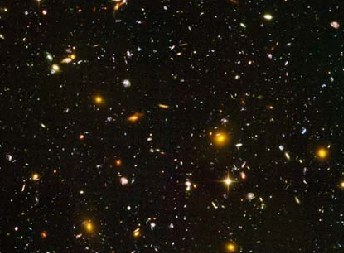We experience only three dimensions in every day life, plus a fourth that we have no control over, time. However, physicists reason that the Universe is not quite so simple. Those entangled in string theory suggest that our Universe has an extra six dimensions of space that are entirely hidden from us. What is puzzling is not the question as to why there are so many dimensions but why we experience the Universe through only three spatial dimensions.
Now, Andreas Karch, of the University of Washington and Lisa Randall of Harvard University reckon they may have unravelled the answer and propose that expansion after the Big Bang led to a dilution effect, a phenomenon they refer to as the relaxation principle. This principle favoured the formation of three- and seven-dimensional realities and it just so happens that the one we live in has three. That’s what comes out when you do the math, says Karch.

Andreas Karch
Karch and Randall wanted to model the arrangement of the Universe immediately after the Big Bang and then determine how the cosmos evolved as it expanded and diluted. The only assumption they made was that the Universe had a smooth configuration initially but was permeated by membrane structures, branes. These branes existed in all possible spatial dimensions from one to nine; all large and none curled up.
The researchers found that as the branes diluted, the ones that survived displayed three dimensions or seven dimensions. In our Universe, everything we see and experience is stuck to one of those branes, and for it to result in a three-dimensional universe the brane must be three-dimensional. Other realities, either three- or seven-dimensional, could be hidden from our perception in the Universe, Karch said.

Lisa Randall
At the fundamental level, dimensions are not purely about human experience. Forces such as electromagnetism only recognise three dimensions. On the other hand, gravity cuts across all dimensions, mathematically speaking. But in a universe of seven dimensions, say, the force of gravity would diminish over much shorter distances than it does in our three-dimensional Universe.

Space (Adapted from NASA/ESA/B.Mobasher)
We know there are people in our three-brane existence, says Karch. In this case we will assume there are people somewhere nearby in a seven-brane existence. The people in the three-brane would have a far more interesting world, with more complex structures, Karch said.
Higher dimensional branes make for more boring worlds, Karch told Spotlight. The force law of gravity between a star and planet in 7D would fall off as the sixth power of the distance between them as opposed to the square in our 3D Universe. With 1/r6 you couldn’t form stable orbits of planets around a sun, he adds. It is impossible to know how a 7D universe would look but it would certainly have less structure and it is difficult to imagine how life would develop under these circumstances. The possibility of stable orbits is what makes the three-dimensional world more interesting, he says.
Karch admits that researchers are only beginning to unravel the implications. But, he admits, the bigger question for most people is probably how anybody could ever have doubted that the Universe is 3D, and not why it came out to be 3 or 7 dimensional!
Further reading
Phys Rev Lett, 2005, in press
http://arxiv.org/abs/hep-th/0506053
Andreas Karch
http://www.phys.washington.edu/users/karch/
Lisa Randall
http://www.physics.harvard.edu/people/facpages/randall.html
Suggested searches
string theory